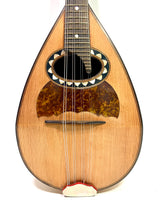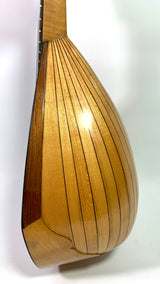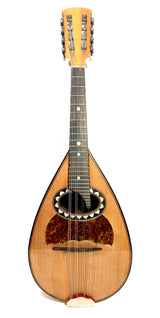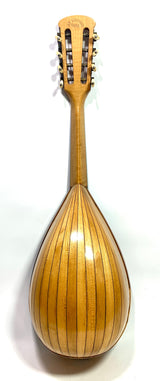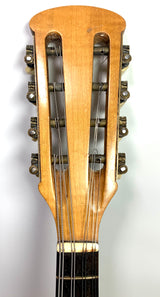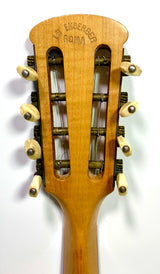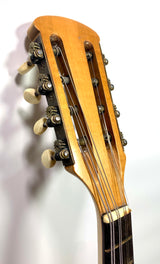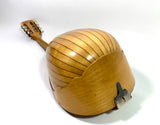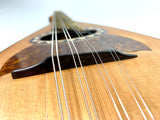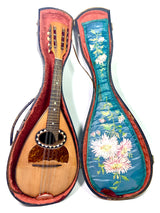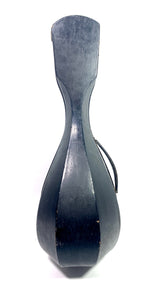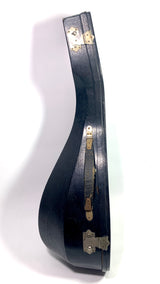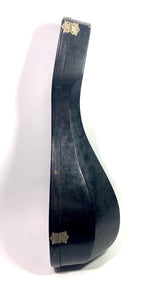Luigi Embergher
Luigi Embergher Orchestra 1 mandolin from 1906
€0
Born in 1856 in Arpino, a small village southeast of Rome, (Antonio) Luigi Embergher comes from a family of wood craftsmen.

Photo by (Antonio) Luigi Embergher
(source: ciociariaturismo.it)
Many families in this province of Frosinone made a living from making wooden tools and machines necessary for the wool industry.
But at the time of Luigi Embergher, for political and economic reasons, this industry was no longer as flourishing as before. And the inhabitants of this province had to change their sector of activity, where to move.
On the other hand, the Embergher family decided to stay in Arpino.
For Luigi, everything was mapped out, he would follow the same path as his ancestors, he would work wood, he would become a cabinetmaker. And it was following a trip to Rome as an apprentice cabinetmaker that he returned to Arpino to work on making musical instruments in the workshop that the Embergher family opened in 1870.




Photograph of the Embergher workshop around 1900
(Source: embergher.com)
Luigi Embergher therefore settled in Arpino and began manufacturing mandolin.
And it was in 1888, thanks to a mandolin signed with its label, that we know that at the age of 32 he freed himself from the family workshop to establish himself as an independent violin maker The following address: Via Marco Agrippa N. 26.
And it was shortly after, in the early 1890s, that he set up his first workshop in Rome: Via dei Greci N. 21.
Then followed several other workshops and changes of address, before arriving in 1906, when he moved to the following address: Via Delle Carrozze N. 19.
Finally, it was in 1915 that he changed his address one last time to settle in Via Belsiana N. 7, until 1960 when the workshop closed.

Advertisement (1928-1933) for the Embergher workshop located Via Belsiana N. 7
(Source: lippi.net)
The mandolin here presents, dates and bears witness to this new workshop located in Rome Via Delle Carrozze N. 19. Dated 1906, the year of its installation at this address, it is a historical landmark of the life and developments of the workshops successive ones by Luigi Embergher.
Possessing a fingerboard with a radius, Embergher's instruments are among those which popularized the Roman school of mandolins.

The Roman mandolin and its place in the history of the Italian mandolin
The Italian Mandolin: Its evolution, nomenclature and types - By Alex Timmerman
(Source: embergher.com)
Although we find certain characteristics from the 18th century, notably with the mandolins of Caspare Ferrari, and the bottom lined with fine spruce shavings placed transversely is also found in the construction of the mandolins of Giovanni Battista Maldura and Giovanni De Santis during the second part of the 19th century.
The latter are also considered the masters or at least one of the strongest sources of inspiration at Embergher.
Some also suppose a passage as an apprentice, of Luigi Embergher, in the workshop of Giovanni De Santis.
Thus Luigi Embergher would therefore be the successor of these master luthiers.
Here this model is an Orchestra 1, so named in the nomenclature of Embergher models and dated 1906.
This is a model designed for orchestral mandolinists, with a concert touch.
In addition to this, certain characteristics, other than the date although correlated with it, make this mandolin a singular example.
In fact, the concert key stops before the edge of the rosette. While in the years that followed, he would replace it with a concert key passing entirely through the rosette.
In addition, this example bears witness to the mandolins of the Embergher era where the protection plate was still symmetrical. Certain models already had, like B types, an asymmetrical protection plate located on the side of the treble strings.
It was in the early 1910s that he "abandoned" the symmetrical pickguards and extended his concert keys so that they ran across the entire soundhole.
Years from which bag popularity and its production increased greatly.
These facts make this Ochestra 1 model from 1906 all the more unique and rare.
Technical characteristics :
- Top: Spruce
- Base: 20 ribs in Maple
- Neck: Maple
- Fingerboard: Ebony
- Width at nut: 25mm
- Radius: Roman type
- Frets: 25 frets
- Scale: 330mm
- Profile: “V” Roman Type
- Pickguard: Tortoiseshell
- Country of manufacture: Italy, Rome
- Year: 1906
- Finish: Natural
- Decorations: Mother-of-pearl fingerboard markers / Maple-Ebony bindings / Triangular mother-of-pearl inlays on the soundhole
- Details: Slight table crack repaired and fixed
With very good playing comfort, this mandolin will delight you with a delicate, balanced sound, with beautiful harmonics, good projection and a timbre typical of Embergher mandolins.
Delivered in a period Neapolitan-style case.
With certificate of authenticity.

